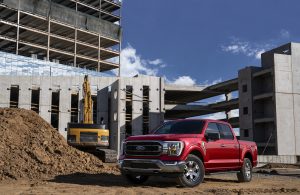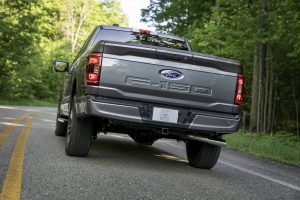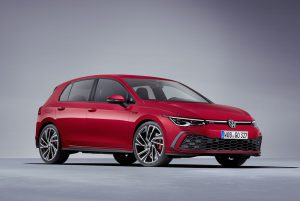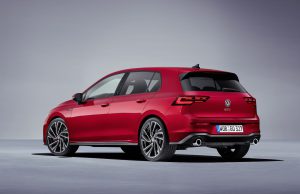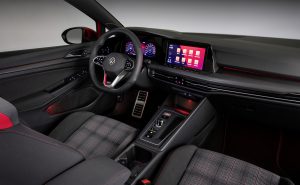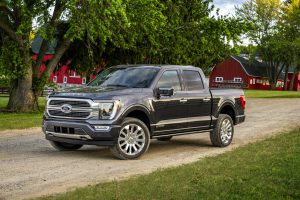
The all-new F-150 Limited features a new exterior design with a bolder and even tougher look. The interior provides more comfort, technology and functionality.
Pandemic be damned, this is going to be a big year for the Ford Motor Co., Detroit’s second-largest automaker rolling out an array of new products as diverse as the reborn Bronco and all-new Mustang Mach-E battery-electric vehicle. But no single model launch will carry the weight of the 2021 Ford F-150.
Along with heavy-duty models, collectively known as the F-Series, they make up the best-selling product line on the U.S. market and, in the process, also generate the vast majority of Ford earnings. So, with the company struggling, its balance sheet falling deeply into the red during the first quarter of this year, the successful launch of the all-new F-150 will be critical.
And the truck that Ford designers and engineers are rolling out during today’s evening web event should have plenty to offer customers. As one would expect of a full-size pickup, there are numerous new features targeting those who count on their trucks to earn a living. That includes more storage, a tailgate designed to serve as a workbench, space to use a laptop computer and several optional onboard generators. There’s also a new business jet-style seat, new safety gear, and Ford’s first hands-free driving system. The 2021 truck also becomes the first F-Series to be offered with a hybrid powertrain.
(Feel the Earth move? Ford shakes things up with 2020 F-Series Super Duty Tremor.)
“This is a game-changing truck,” said Todd Eckert, the marketing manager for Ford Truck, during a media background briefing earlier this week. “It’s the toughest, most productive F-150 ever.”
Ford was one of the first automakers to roll out a pickup – though who actually was first is a matter of long debate. What’s clear is that it gained market dominance earlier on in the 43-year history of the F-Series, and has no intention of ceding its sales crown anytime soon.
The new model won’t qualify as the most radical F-150 update in Ford history. That claim almost certainly belongs to the outgoing generation which saw Ford shift from steel to an “aluminum-intensive” design featuring a mostly steel chassis and a body primarily reliant on military-grade aluminum alloys. With a few tweaks, that approach carries over into the 2021 remake, Chief Engineer Craig Schmatz told TheDetroitBureau.com.
The switch to aluminum had several benefits, according to Ford, notably cutting as much as 700 pounds off the mass of the earlier, all-steel truck. The automaker continued to emphasize weight savings this time around, said Schmatz, though that might not be immediately apparent.
“We’re offering a lot of new features and technology (on the 2021 model) that add more weight,” he explained. “Our strategy has been to offset the (added) weight with selected other efficiency actions,” such as going from a heavy steel to a lightweight magnesium instrument panel crossbeam.
Visually, Ford opted for an evolutionary approach to the new F-150. Those familiar with the truck will likely notice many of the new design details, though the 2021 model won’t stand out like the latest-generation Ram 1500.
Pushing beyond what we’ve seen with the last-generation F-Series array, the various new versions of the F-150 will get distinct elements, including lights and grilles so you can tell a base model from the elite F-150 Limited that is likely to come very close, if not cross over, the $100,000 mark when all the possible option boxes are ticked.
All told, there will be three different headlights: halogen, LED reflectors and LED projectors with dynamic bending. There will be 11 different grilles, an assortment of body styles and box lengths, even 13 different wheels, ranging from 17-inch painted steel to 22-inch alloys.
The details that link all the variants include wheels pulled out by about ¾ of an inch to create a “more planted…powerful stance,” said chief designer Ehab Kaoud, as well as C-Clamp headlights, “power dome” hoods, larger tire diameters, round wheel openings and raised front fenders.
(First Drive: 2020 Ford F-Series Super Duty.)

Many of the changes are functional, such as the active grille shutters standard on all models that contribute to an average 3% improvement in aerodynamics.
Many of the changes are functional, such as the active grille shutters standard on all models that contribute to an average 3% improvement in aerodynamics. Optional new power running boards now stretch beneath the cargo box to make it easier to climb up to reach goods or tools. The board can be remotely deployed or operated with a foot waggle, much like the auto tailgates on many Ford SUVs.
Under the power dome hood, Ford will offer buyers what it bills as the widest array of powertrain options available. These include five familiar packages:
* The base, naturally aspirated 3.3-liter V-6;
* The turbocharged 2.7-liter EcoBoost V-6;
* The 3.5-liter turbo EcoBoost V-6
* The 5.0-liter naturally aspirated V-8; and
* The 3.0-liter PowerStroke turbodiesel V-6.
Ford has yet to release horsepower, torque, fuel-economy or towing numbers for the 2021 F-150 powertrain options, though it claims it will be upgrading them and we know that the PowerStroke diesel currently maxes out at 11,500 pounds towing.

(left to right) All-new F-150 Limited in Smoked Quartz Tinted Clearcoat, F-150 Lariat in Rapid Red Metallic Tinted Clearcoat and F-150 XLT Sport Appearance Package in Carbonized Gray.
The “most capable” offering for 2021, however, is set to be the all-new 3.5-liter PowerBoost, a full hybrid which, according to a Ford statement, “is targeted to have the most torque and horsepower of any light-duty full-size pickup, at least 12,000 pounds of maximum available towing capacity and a targeted EPA-estimated range of approximately 700 miles on a single tank of gas.”
As you might expect, Ford wanted to use the hybrid drivetrain – which draws energy from a 1.5 kilowatt-hour lithium-ion battery – to do more than just boost mileage. Among the numerous additional features coming with the hybrid, there’ll be a built-in 2.4 kilowatt generator. Various F-150 models, including the hybrid, will be available with three different generator packages, ranging from 2.0 kW to 7.2 kW. And they’ll be able to provide 120 and/or 240-volt current.
There are plenty of features aimed to make work a little easier. That includes details as small as the ruler now built into the tailgate, and lighting that can spot the tailgate when folded down. These days, part of the workday can involve getting online.
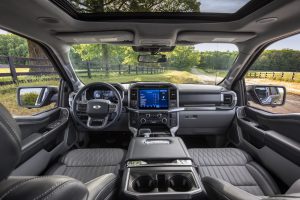
The cabin is completely redesigned with more comfort, technology and functionality along with more premium materials, more color choices and more storage.
It’s not uncommon for current F-150 owners to “spend hundreds of dollars” on ready-made solutions, “or come up with their own hacks” to create a place to lay out a laptop or tablet computer, said Engineering Manager Dawn Piechocki. The 2021 truck can be equipped with a foldaway shifter on the center console that creates a flat surface to work on.
The F-150 is itself loaded with smart technology, starting with larger touchscreens – now either 8- or 12-inch. Unlike some competitors, however, Ford retained buttons for numerous vehicle functions, such as climate control, something it said owners forcefully demanded. The infotainment system is the latest take on Ford Sync. This now permits optional wireless versions of Apple CarPlay and Android Auto. And it pairs with an updated Ford Pass smartphone app that can operate or check on a variety of vehicle functions.
Then there’s CoPilot 360, with an array of standard advanced driver assistance systems, such as forward collision warning with automatic emergency braking. Upgrades add features like blind-spot detection and active cruise control.
The 2021 F-150 will become the first vehicle in the full-size segment coming standard with smartphone-style Over-the-Air, or OTA, updates. These will allow Ford to revise onboard software, even add new features automatically, said Stuart Taylor, executive director of the automaker’s connectivity team, adding that “updates will be short, often completely invisible.”

Pro Trailer Backup Assist makes backing up a trailer as easy as turning a knob; and the F-150 is the only light-duty full-size pickup with this feature.
One of the features expected to become available next year will be Active Drive Assist, a technology Ford announced earlier this month for the Mach-E long-range battery-SUV. It will permit a motorist to drive completely hands-free on about 100,000 miles of U.S. limited-access roadways that have been mapped in super-high resolution. The hardware will be pre-installed when the new F-150 goes on sale late this year, though the software for the system is still being finalized. Owners will be able to buy and then remotely download the program when it’s ready – or go to a dealer to have it installed.
Among other technology, the new F-150 will be offered with an array of cameras providing various views, including one that essentially lets you look back while towing as if there was no trailer.
The launch of the new F-150 is “a pivotal moment for Ford,” said analyst Jessica Caldwell, of Edmunds, so the automaker will be working hard to avoid the production snafus that fouled the early run of the new Explorer last year. The first F-150 plant is already ramping up, with two other plants to go online in the coming months.
(Ford planning mid-2022 to launch F-150 EV.)
Expect to see the 2021 Ford F-150 reach U.S. showrooms in November or December, said Eckert. Pricing will be revealed closer to launch, but analysts would be surprised if the numbers don’t climb a bit considering all the new content, with Edmunds forecasting the average new truck will roll off the lot at around $50,000.
